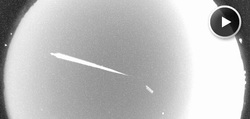
UPDATE: INCOMING CME At first this CME did not appear heading for Earth. However, a new analysis by forecasters at the Goddard Space Weather Lab shows that the cloud will indeed hit Earth's magnetic field on Feb. 26th at 13:30 UT (+/- 7 hr): animated forecast track. Geomagnetic storms are possible when the CME arrives.


 RSS Feed
RSS Feed